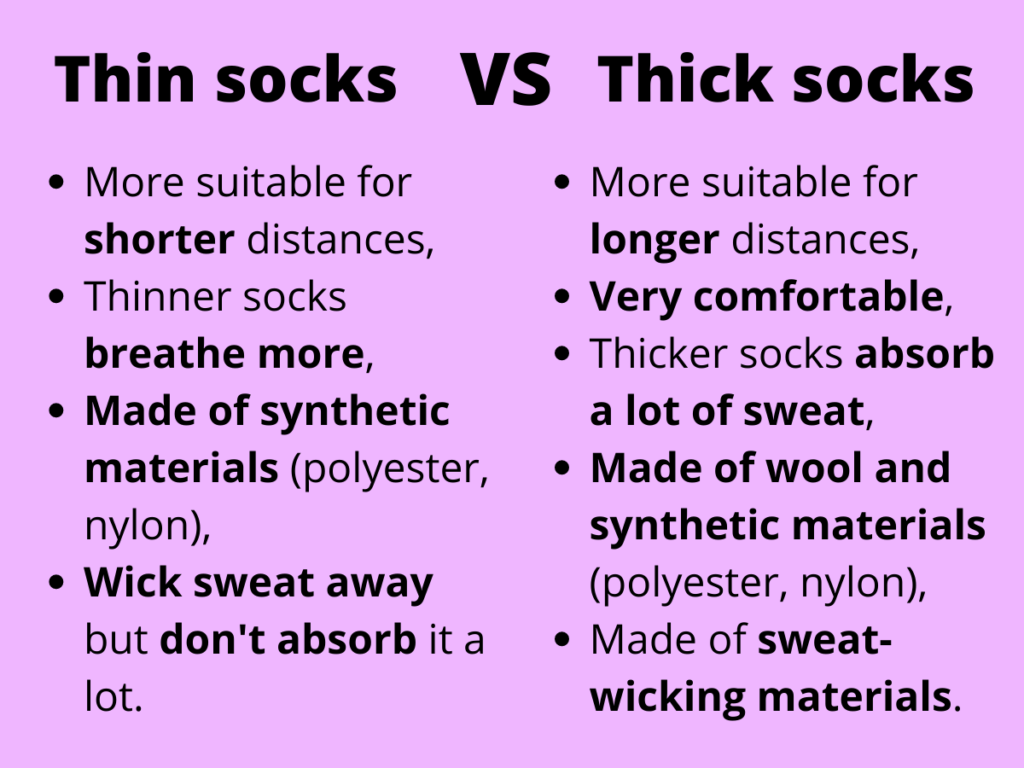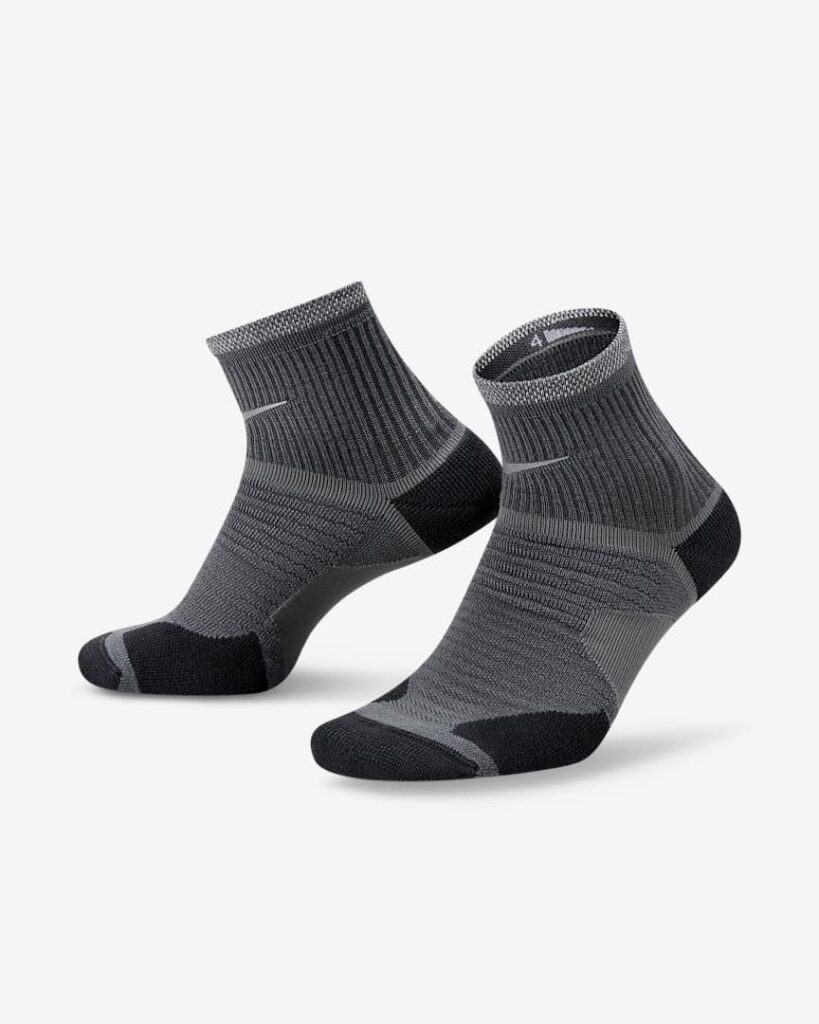When it comes to the development of sportswear and footwear, manufacturers’ progress knows no boundaries. Year after year, leading brands seek new solutions to make their clothing as light and comfortable as possible. It’s no different with the development of running socks. Should your running socks be thinner or thicker to support you in beating your personal record in a 10k, 21k, or marathon?
The thinner the running socks, the better they breathe. The thicker the socks, the more comfortable they are, absorbing more sweat and protecting the foot from chafing and blisters. Thicker socks are better for longer distances like half marathons, marathons, and ultra-runs. Thin socks are better for shorter runs and sprints.
Should I choose thinner or thicker running socks? I’ll tell you the advantages of both socks, and when to use them, so you can get a better idea of which one to buy next time.
Are thicker socks better for your feet?
Thick socks are more comfortable and offer more protection. They are more padded in the toe and heel areas, making them more comfortable and soak up more sweat. The foot stays dry for longer, which is more comfortable for running and prevents blisters and athlete’s foot during running.
Do cushioned socks make a difference? I suggest you read this post and find the answer to this question.

Thicker socks are best for long-distance running (half marathon, marathon, and ultra) because their comfort only shows after a few hours of running. This is what happens to the foot during a run of several hours:
- the foot is constantly sweating, which can cause foot infections and blisters,
- with each step, the toes rub against each other and against the shoe (on average, 55,000 – 60,000 steps are taken during a marathon).
Which material is best for thick socks?
The best material for thicker running socks is merino wool mixed with polyester or nylon. All three materials are very breathable, which ensures that the foot always has fresh air flow and therefore sweats less.
Merino wool and nylon can absorb a lot of sweat, so it doesn’t stay on the foot but are absorbed into the sock, keeping the foot dry for longer. Merino wool, polyester, and nylon are also good sweat-wicking materials, so excess sweat that they can’t absorb is pushed away from the skin, keeping the foot dry for longer.
Feet sweat constantly when running, but some people wear the same socks twice a row. I did a test to see if it is good to wear the same socks more than once.
Why is it important to keep your feet dry for as long as possible? The toes are constantly rubbing against each other and the shoe as you run. If you run with wet feet, this rubbing is even more intensive. Because the foot is kept in the dark, enclosed, and humid place for several hours during long-distance running, this is the ideal environment for blisters, fungus, and athlete’s foot. These are the biggest enemies of runners because they make running less comfortable, and therefore, we cannot achieve our best result.
Rubbing your toes while running can be eased by wearing toe running socks because each toe is in its own space. How to choose the right toe running socks can be found here.
Cotton is not a good material for running socks because it absorbs a lot of sweat but doesn’t wick it away and dry as quickly as wool and nylon. By wearing cotton socks when running, your feet will always be in a moist environment, which can lead to blisters, fungus, and athlete’s foot on longer runs.
You can read more about the choice of materials for running socks by clicking on this link, where I compared 5 different materials.
Should running socks be thin?
If you want your foot to breathe well during your run, I recommend wearing thinner running socks. Thin running socks are made of synthetic materials because they have thin fibers and are very light. The most commonly used materials are polyester, nylon, and elastane.
I recommend wearing thin running socks, especially for shorter distances (less than 1 hour of running). Because your feet sweat less during this time and you will spend less time running in wet shoes. Thinner socks do not absorb much sweat, as polyester and elastane are not absorbent materials. Even if you wear socks made of nylon, a more absorbent material, the sock is too thin to absorb a significant amount of sweat. Thin running socks are more suitable when running a distance of 10k or doing interval training.
Do you know how often you should change your running socks? Read these 9 signs to know when it’s time to change your running socks.
Now let’s look at how to choose the right socks for 10k, 21k, and marathon distances.
How Do You Pick Out Running Socks?
The right pair of running socks should fit your foot well. The material of the running socks must be breathable, wicking, sweat-absorbent, and comfortable. The socks must not disturb you while running and must prevent you from getting blisters and foot infections.
Let’s see which socks I wear for shorter distances when I run for training and which I wear when I run half marathons and marathons.
Socks for 10k distance
For me, a shorter distance run is a run of up to 10 kilometers or less than an hour. It’s not so long that the leg is in a humid and dark environment for hours. And that’s why I prefer to wear thinner socks during shorter runs because they are more light and breathable. But I still take care in the choice of materials. I like nylon more than polyester because it absorbs sweat well and keeps my feet dry for longer during the run.
When choosing running socks, check the composition of the materials. For thinner socks, choose socks that have at least 50% nylon; the rest can be polyester or elastane.
Socks for half-marathon and marathon distance
When I run a half marathon or a marathon, the choice of running socks is the same. In choosing my running socks, I have copied the best in the sport, and the best in the best marathon runner in the world at the moment is Eliud Kipchoge. I looked at Eliud’s socks when he set the world record. Eliud has a sponsorship deal with Nike, so of course, he wears Nike socks, but I was more interested in the composition of the socks than the brand.

The composition of the socks in the picture below is 47% wool/25% polyester/23% nylon. This means that Eliud was wearing thicker socks with three different materials. Wool, polyester, and nylon are materials that breathe very well, and such socks absorb sweat very well. This keeps the foot dry for longer and makes running more comfortable.

I’m not saying that you should necessarily buy Nike running socks now. These socks cost $23, which is too expensive for many people. You can buy any socks if you want, but pay attention to the composition. They should contain at least one material that absorbs sweat well (wool or nylon). This will also give you a material that breathes well.
Eliud Kipchoge can run a marathon in just over two hours. For amateur runners, the average marathon distance takes 3-4 hours. Therefore, the foot is in the shoes for longer, and it is even more important to keep it dry.
